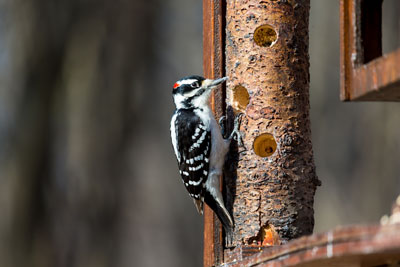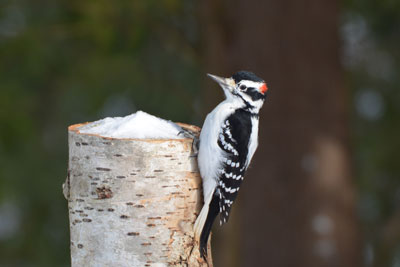




If you live in or near a wooded area, you are probably familiar with the rhythmic drumming of woodpeckers – it signals the onset of the nesting season and is a welcome sign of spring. Woodpeckers are some of our most familiar backyard birds: With their distinctive coloration and the tendency to creep up the trunks of trees they are often easy to observe. Montana is home to 10 species of woodpeckers: downy, hairy, three-toed, black-backed, pileated, Lewis’s, and red-headed woodpeckers, red-naped and Williamson’s sapsuckers, and the northern flicker. All are in the pamily Picidae and can be collectively called woodpeckers.
Most woodpecker species can be observed foraging on snags or partially dead trees, searching for wood-boring insects. Landowners can be wildlife friendly by leaving dead trees standing to maintain this habitat. Some woodpeckers specialize on other food sources: sapsuckers, as their name implies, eat sap in addition to insects; flickers spend a lot of time on the ground probing the soil for ants; and Lewis’s woodpeckers behave like flycatchers – sallying out to catch bees and other flying insects.
Sapsuckers bore small parallel rows of holes in the trunk or limbs of trees to make the sap flow, and they maintain these wells throughout the day. Sapsuckers eat the sap and insects caught in the sap; hummingbirds may visit these sap wells, too – a neat wildlife viewing opportunity. The sap wells rarely cause permanent damage to a tree. However, if the trunk is girdled with holes, it could kill the tree or provide an entrance for disease or insects. If protection is necessary the entire trunk or damaged area can be wrapped with burlap, plastic mesh, or hardware cloth.
This is the sound created by a woodpecker’s bill tapping in a very rapid, rhythmic succession on metal or wood. Each spring woodpeckers attempt to establish territories and attract mates. Males and females both advertise by drumming, as loudly as possible, on the best sound-producing object available. Historically, this would have been a hollow snag or the top of a dying tree. But thanks to humans, the possibilities are now endless: wood and aluminum siding, utility poles, downspouts, gutters, chimney caps, roof flashing, TV antennas, and stop signs to name a few. Drumming starts each day at dawn and can continue for several days or months. Though it causes little or no damage it may be heard throughout the house and can be very annoying to a homeowner. The best way to deter a woodpecker from drumming is to get rid of the source of the sound. Woodpeckers prefer to drum on surfaces that resonate, so secure loose boards or use filler behind boards that sound hollow. Temporarily cover chimney caps or other metal with cloth, foam rubber, or insulation. Take away the sound, and the woodpecker will likely move on.
Woodpeckers can cause damage to houses when seeking insects, and once a feeding area is established the bird will be persistent. It’s important to maintain the exterior of homes to prevent insects from moving in. If insects are the attractant, it’s best to take care of the infestation before trying to exclude or deter the woodpecker. The services of a professional exterminator may be needed. Apply pesticides that are safe to use around birds.
Both male and female woodpeckers excavate cavities for nesting and roosting outside the breeding season. A woodpecker may start to make a hole, then abandon it only to start another hole – often just inches away from the first hole. A structure may be damaged by any number of half-finished holes. Even if these holes are not large enough for the woodpecker they may be adequate for starlings or house sparrows, so it is necessary to repair holes of all sizes promptly. Once woodpeckers have eggs or young, it is illegal to remove them from the nest or to scare the adults away, per the Migratory Bird Treaty Act. Consider providing a nest box designed specifically for the offending woodpecker species as an alternative nest site.
Woodpeckers, like all native birds for which there are no hunting seasons, are federally protected under the Migratory Bird Treaty Act. Because trapping and shooting are not permitted homeowners will need to be creative in discouraging nuisance woodpeckers; understanding their biology may help identify a successful deterrence strategy. Woodpecker noise generally falls into one of three categories: advertising, feeding, or excavating a nest hole. Woodpeckers may be attracted to homes for any of these activities. If a woodpecker takes a liking to your home, successful deterrence depends upon the following:
Woodpeckers may damage homes made of wood, stucco, and DryVit. Homes with the following types of siding are most vulnerable: cedar (especially natural or stained an earth tone), grooved plywood, tongue-and-groove, and aluminum or vinyl (for drumming). Siding that is painted, especially in shades of white, pastels, or bright colors, may be less attractive to woodpeckers.
Scare tactics are generally effective for only a few days before the birds realize they are not a threat, so use a variety of techniques until they give up and move on.
Woodpeckers and sapsuckers are migratory birds and are federally protected. When warranted, a bird may be killed under a special permit from the U.S. Fish and Wildlife Service. Before a permit will be issued it must be demonstrated that other methods of exclusion or deterrence were attempted first. Contact the nearest U.S. Fish and Wildlife Service office for details.
To protect siding, woodpeckers can be excluded through the use of ¾-inch lightweight bird netting. Leave at least 3 inches of space between the netting and the building so birds can’t cause damage through the netting. Netting can also be attached to the eaves and angled back to the siding to hang below the damaged area. Secure it taut to ensure that bird can’t get trapped behind it. When properly installed netting is nearly invisible from a distance and is a long-term solution.
Scare tactics are generally effective for only a few days before the birds realize they are not a threat, so use a variety of techniques until they give up and move on. Visual deterrents that use movement and reflective light may frighten a woodpecker away. Try using items such as pinwheels, wind chimes, windsocks, old CDs, aluminum pie pans, strips of aluminum foil, scare tape, plastic streamers, Mylar party balloons, or a scare balloon with large eyes. Attach or hang them over the damaged area so they can move freely in the breeze. Hanging a plastic owl or silhouette of a falcon has had some success scaring woodpeckers but silhouettes of other animals do not seem to be effective.
When you hear drumming or pecking, try harassment techniques like shouting or banging on pots. You may try squirting a small amount of water from a hose or throwing tennis balls near the bird. Electronic distress call systems are also available for purchase. Chemical or odor repellents have generally proven ineffective.
Woodpeckers and sapsuckers are migratory birds and are federally protected. When warranted, a bird may be killed under a special permit from the U.S. Fish and Wildlife Service. Before a permit will be issued it must be demonstrated that other methods of exclusion or deterrence were attempted first. Contact the nearest U.S. Fish and Wildlife Service office for details.
